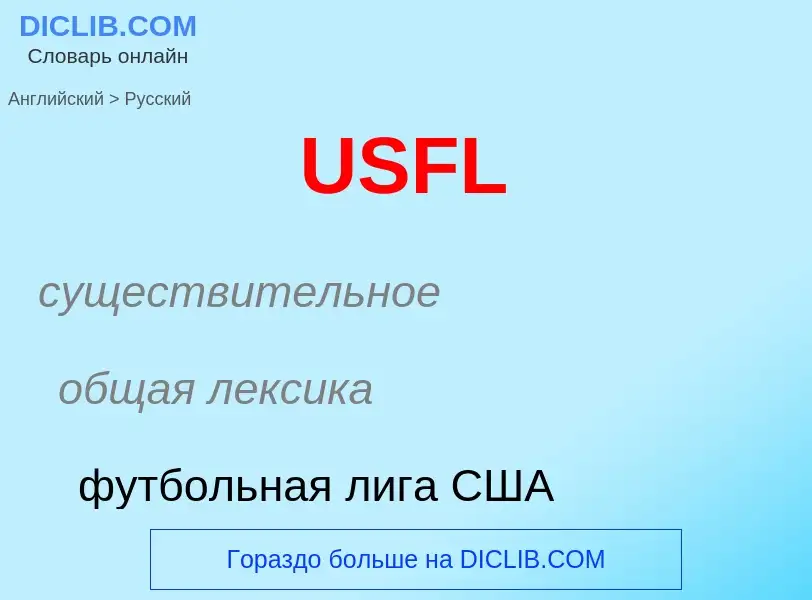Vertaling en analyse van woorden door kunstmatige intelligentie ChatGPT
Op deze pagina kunt u een gedetailleerde analyse krijgen van een woord of zin, geproduceerd met behulp van de beste kunstmatige intelligentietechnologie tot nu toe:
- hoe het woord wordt gebruikt
- gebruiksfrequentie
- het wordt vaker gebruikt in mondelinge of schriftelijke toespraken
- opties voor woordvertaling
- Gebruiksvoorbeelden (meerdere zinnen met vertaling)
- etymologie
USFL - vertaling naar russisch
существительное
общая лексика
футбольная лига США
синоним
Wikipedia

The United States Football League (USFL) was a professional American football league that played for three seasons, 1983 through 1985. The league played a spring/summer schedule in each of its active seasons. The 1986 season was scheduled to be played in the autumn/winter, directly competing against the long-established National Football League (NFL). However, the USFL ceased operations before that season was scheduled to begin.
The ideas behind the USFL were conceived in 1965 by New Orleans businessman David Dixon, who saw a market for a professional football league that would play in the summer, when the National Football League and college football were in their off-season. Dixon had been a key player in the construction of the Louisiana Superdome and the expansion of the NFL into New Orleans in 1967. He developed "The Dixon Plan"—a blueprint for the USFL based upon securing NFL-caliber stadiums in top TV markets, securing a national TV broadcast contract, and controlling spending—and found investors willing to buy in.
Though the original franchise owners and founders of the USFL had promised to abide by the general guidelines set out by Dixon's plan, problems arose before the teams took the field, with some franchises facing financial problems and instability from the beginning. Due to pressure from the NFL, some franchises had difficulty securing leases in stadiums that were also used by NFL teams, forcing them to scramble to find alternative venues in their chosen city or hurriedly move to a new market. The USFL had no hard salary cap, and because of this, some teams quickly escalated player payrolls to unsustainable levels despite pledges to keep costs under control. While a handful of USFL franchises abided by the Dixon Plan and were relatively stable, others suffered repeated financial crises, and there were many franchise relocations, mergers, and ownership changes during the league's short existence; however, none of its teams actually folded during any given season. These problems were worsened as some owners began engaging in bidding wars for star players against NFL teams and each other, forcing other owners to do the same or face a competitive disadvantage.
On the field, the USFL was regarded as a relatively good product. Many coaches and team executives had NFL experience, and many future top NFL players and coaches got their start in the new league, including several who were later inducted into the Pro Football Hall of Fame and/or the College Football Hall of Fame. The Michigan Panthers won the first USFL championship in 1983. The Philadelphia Stars won the second USFL championship in 1984, and after relocating to Baltimore, won the final USFL championship in 1985 as the Baltimore Stars in what was effectively a rematch of the first USFL title game.
In August 1984, the USFL voted to move from a spring to a fall schedule in 1986 to compete directly with the NFL. This was done at the urging of New Jersey Generals majority owner Donald Trump and a handful of other owners as a way to force a merger between the leagues. As part of this strategy, the USFL filed an antitrust lawsuit against the National Football League in 1986, and a jury ruled that the NFL had violated anti-monopoly laws. However, in a victory in name only, the USFL was awarded a judgment of just $1, which under antitrust laws, was tripled to $3. This court decision effectively ended the USFL's existence. The league never played its planned 1986 season, and by the time it folded, it had lost over US$163 million (over $389 million in 2021 dollars).


![Doug Flutie and [[Donald Trump]] at a New Jersey Generals football press conference in February 1985 Doug Flutie and [[Donald Trump]] at a New Jersey Generals football press conference in February 1985](https://commons.wikimedia.org/wiki/Special:FilePath/Doug Flutie, Donald Trump, Generals football press conference.jpg?width=200)

